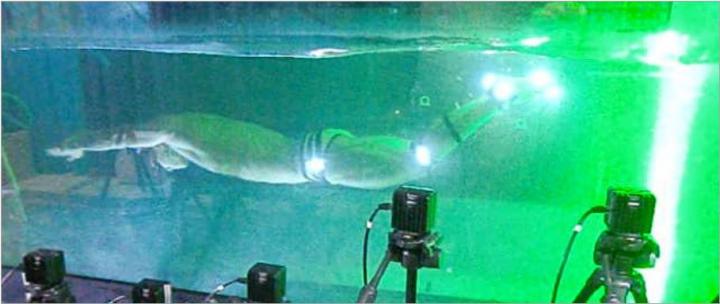Researchers led by the University of Tsukuba produce the most detailed motion capture of undulatory swimming and the resulting 3D flow velocity field, which shows promise for new underwater propulsion systems

Credit: University of Tsukuba
Tsukuba, Japan – A research team led by the University of Tsukuba created the most complete recording to date of a human swimming underwater like an eel or lamprey. Using motion capture equipment and particle velocity monitors, the scientists were able to study this “undulatory” underwater propulsion and the nearby water flows it created. They found that jets produced by coalescing vortices help explain the efficiency of this swimming method, which might be applied to novel propulsion systems.
If you watch an Olympic swimming event, you may be surprised to see the athletes wriggling like eels when starting the race or just after turning around. Regardless of the type of swimming stroke used for the rest of the lap, these competitors have discovered that this undulatory motion is the best way to accelerate quickly. However, it was not previously known why this is the case, and a better understanding of underwater propulsion can lead to more efficient submarines and ships. For this research, a national-level swimmer was recorded swimming in a water flume while wearing 18 LED markers. Streams of microbubbles were used as tracers of the 3D water velocity fields. This allowed the scientists to more fully understand the source of the swimmer’s thrust while undulating underwater.
“Propulsion through a fluid, whether air or water, usually relies on the principle of conservation of momentum,” explains author Hirofumi Shimojo. “For example, pushing water backwards with your hands or feet when swimming in the ocean will make you move forward. Similarly, a jet engine can zoom through the sky by pushing a stream of air backwards out of its engines.”
The researchers saw that the swimmer’s downward kick created leading-edge vortices that moved from the front to the back of his feet. After these vortices were shed from the swimmer’s body, they combined into a “vortex wake,” which led to a jet of water flow that propelled him forward.
“Our work shows the importance of visualizing the complex water flows to understanding the origin of propulsion efficiency. In this case, the swimmer gains thrust from his downward kick due to the vortices and jet flow in his wake,” says senior author Hideki Takagi.
These findings could potentially provide insight beyond human motion. Adds Shimojo, “This work may help us to understand the wakes created by other forms of underwater propulsion, including those that power boats and submarines.”
###
Media Contact
Naoko Yamashina
[email protected]
Related Journal Article
http://dx.




